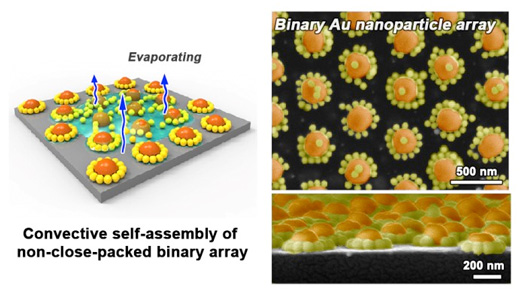| Mar 18, 2021 |
Self-assembly of 2D nonclose-packed binary gold nanoparticle arrays with tunable optical properties
(Nanowerk News) A binary nanoparticle array refers to a periodic structure comprising at least two types of building nanoparticles with component or morphological dissimilarities. Synthetic binary arrays can not only boost structural diversity, but also new optical or thermoelectronic properties synergized from different components.
|
|
Current methods, which used to modulate the self-assembly of different building blocks into various binary arrays, usually require a sophisticated surface modification process for both the building blocks and the substrate. Therefore, there is urgent need for a general strategy that is untethered to the building block feature and avoids the specified surface modifications.
|
|
Recently, researchers led by Prof. LI Yue from the Institute of Solid State Physics of the Hefei Institutes of Physical Science successfully fabricated a two-dimensional (2D) nonclose-packed (NCP) binary Au nanoparticle arrays (Chemistry of Materials, "Convective Self-Assembly of 2D Nonclose-Packed Binary Au Nanoparticle Arrays with Tunable Optical Properties"). They modulated the convective self-assembly of colloidal nanoparticles on a templating NCP nanoparticle array and developed an ethylene glycol (EG)-mediated approach.
|
 |
| Convective self-assembly of non-close-packed binary array. (Image: XING Changchang)
|
|
By using EG solvent as the nanoparticle carrier and evaporating media, and taking advantage of its ultralow equilibrium vapor pressure, the researchers mitigated the coffee ring effect caused by convective evaporation.
|
|
These Au arrays demonstrate multiple tunable optical properties, based on tunable plasmonic coupling among the Au nanoparticles.
|
|
This approach, allowing colloidal nanoparticles to stack around the templating ones, was generalized for various types, shapes, and periodicities of building nanoparticles. "It formed a 'core-satellite' basic architecture," said XING Changchang, a PhD student who joined the research.
|
|
This research paves the way for the development of a new category of NCP binary arrays and helps to explore their collective unconventional properties.
|

